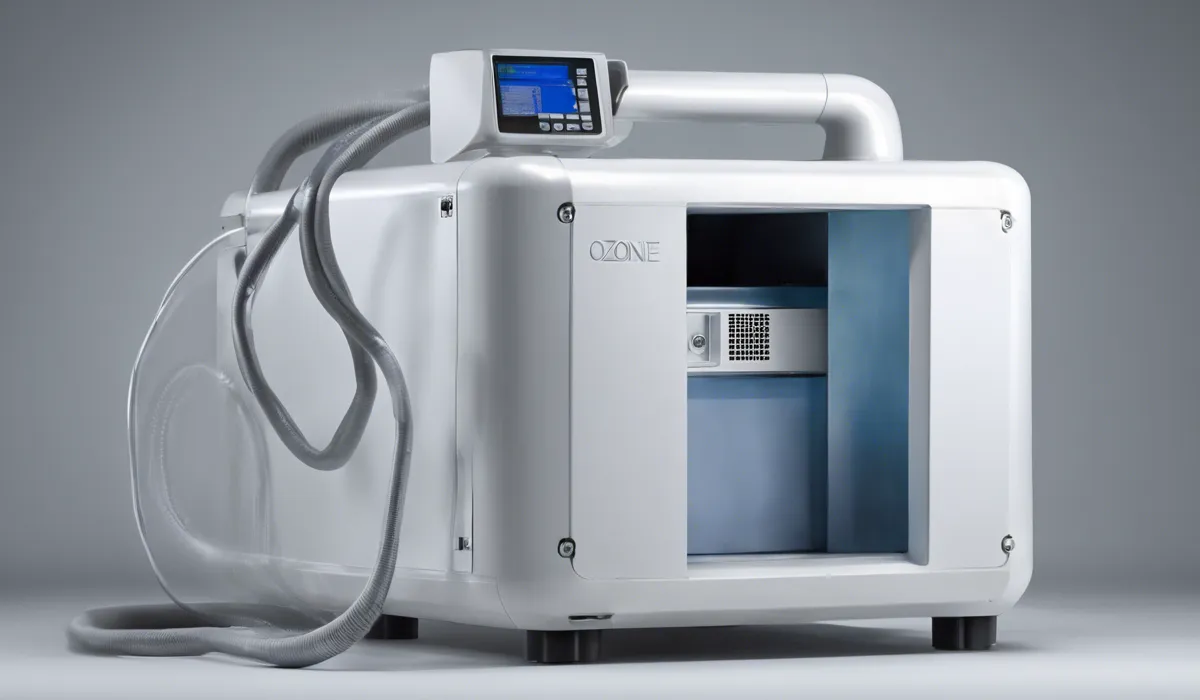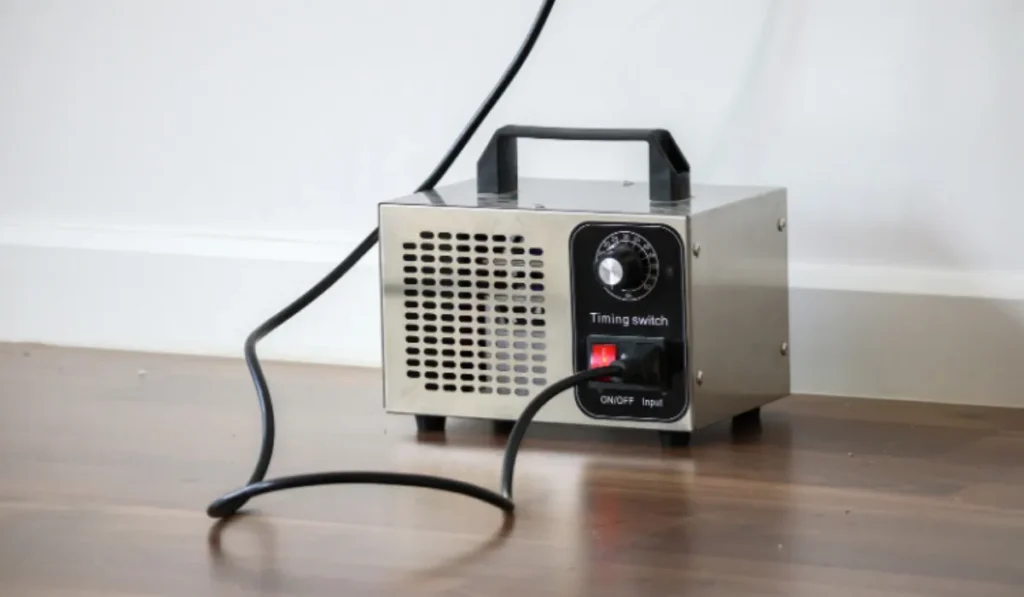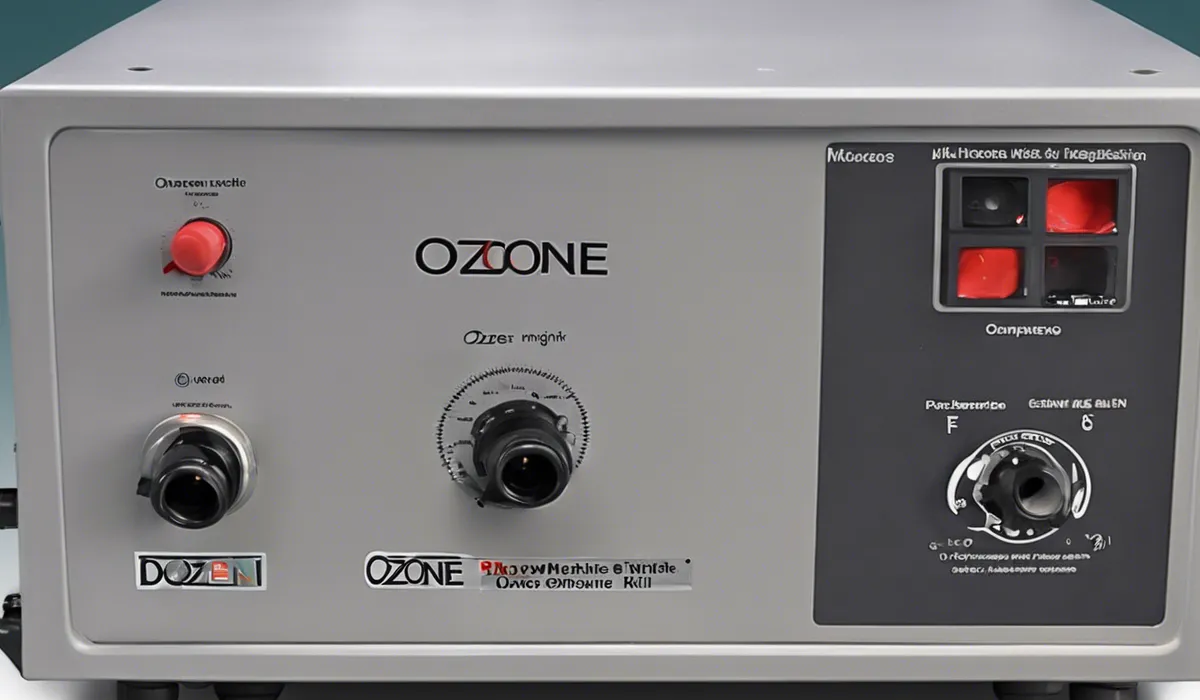Ozone machines can kill mold on surfaces by disrupting mold spores at a molecular level. However, they can’t eliminate mold completely, especially within deep surfaces or porous materials. It’s essential to address the moisture source to prevent recurrence.
Understanding Ozone Machines and Their Function

What is Ozone and How Do Ozone Machines Work?
Ozone is a molecule made up of three oxygen atoms. Naturally, it forms a protective layer in our atmosphere.
Ozone machines are devices designed to produce ozone gas on demand. They mimic nature’s process through an electrical discharge, like lightning, to split normal oxygen molecules in the air into individual atoms.
These atoms then attach to other oxygen molecules to create ozone.
Ozone Generation Techniques Used by Ozone Machines
Ozone machines typically use two methods to generate ozone: ultraviolet light and corona discharge.
Ultraviolet light mimics the sun’s natural UV rays to produce ozone, while corona discharge creates a controlled electrical field that generates a high voltage arc, splitting oxygen molecules.
Removing Odors with Ozone Machines
One common use of ozone machines is to remove unpleasant smells. Ozone reacts with odor-causing molecules, altering their chemical structure, which neutralizes the smell.
This makes them excellent for use in homes, cars, and hotels.
Ozone Machines for Air Purification
Ozone machines are also used to purify the air. When released into a room, ozone can neutralize pollutants, bacteria, and viruses, making the air cleaner and healthier to breathe.
Effectiveness of Ozone Machines Against Mold

Ozone’s Interaction with Mold at the Molecular Level
Ozone attacks mold by penetrating the cell walls and disrupting the mold spores’ vital processes, leading to their destruction.
This process occurs at the molecular level and is effective against mold on surfaces where the ozone can reach.
What Research Says About Ozone Killing Mold?
Studies have shown that high levels of ozone can kill mold in controlled conditions. However, these studies also emphasize that ozone must be used correctly to be effective, and it is not a standalone solution for mold problems.
Concentration and Exposure: Key Factors in Ozone Effectiveness
The concentration of ozone and the duration of exposure are critical in determining the effectiveness of ozone machines against mold.
Higher concentrations and longer exposure times increase the chances of killing mold, but also raise safety concerns.
Environmental Conditions Impacting Ozone’s Mold-Killing Power
Environmental factors like humidity, temperature, and air flow affect how well ozone works against mold.
For example, high humidity can reduce ozone’s effectiveness, while proper air circulation can help distribute ozone more evenly.
Safety and Considerations When Using Ozone Machines

Health Risks of Ozone Exposure
Ozone can be harmful to human health, especially the respiratory system. Breathing in ozone can lead to throat irritation, coughing, chest pain, and lung inflammation.
It’s crucial to avoid being in the same room as an operating ozone machine.
Best Practices for Operating Ozone Machines Safely
When using an ozone machine, follow safety guidelines like using it in unoccupied spaces, setting a timer, and allowing the ozone to dissipate for several hours before re-entering the room. Always read the manufacturer’s instructions carefully.
Alternatives to Ozone for Mold Remediation
Other methods for mold remediation include using natural fungicides like vinegar or tea tree oil, using chemical mold removers, and improving ventilation and humidity control to prevent mold growth.
When to Choose Professional Mold Remediation Over DIY Ozone Use?
For extensive mold problems, or when mold is in hard-to-reach places, professional remediation is often the safer and more effective choice.
Professionals have the training, experience, and equipment to handle mold safely and thoroughly.
FAQs About Ozone Machines and Mold
Does an ozone machine effectively kill mold?
Ozone machines can kill mold on surfaces by disrupting mold spores at a molecular level, but they may not reach all areas where mold is present.
Can an ozone machine remove all mold in a home?
No, an ozone machine cannot eliminate mold completely, especially within deep surfaces or porous materials.
Is ozone treatment enough to prevent mold from coming back?
While ozone treatment can help kill surface mold, it is essential to address the moisture source to prevent mold recurrence.
Are ozone machines safe to use in homes for mold remediation?
Ozone machines should be used with caution as ozone is a powerful oxidant and can be harmful to breathe in; it’s best to use them when the space is unoccupied.
How long does it take for an ozone machine to kill mold?
The time it takes for an ozone machine to kill mold can vary depending on factors like the size of the area, the concentration of mold, and the machine’s output, but it generally takes several hours.
Final Thoughts
Ozone machines have the capability to disrupt mold spores on surfaces at a molecular level, thus killing mold in the affected areas.
However, they are not a complete solution for mold problems, as they cannot reach into deep or porous materials. To ensure mold does not return, the underlying moisture issue must be resolved.
Useful Resources
- https://ww2.arb.ca.gov/our-work/programs/air-cleaners-ozone-products/hazardous-ozone-generating-air-purifiers
- https://www.epa.gov/indoor-air-quality-iaq/ozone-generators-are-sold-air-cleaners
- https://portal.ct.gov/-/media/Departments-and-Agencies/DPH/dph/environmental_health/eoha/pdf/ozonegeneratorfactsheetpdf.pdf
